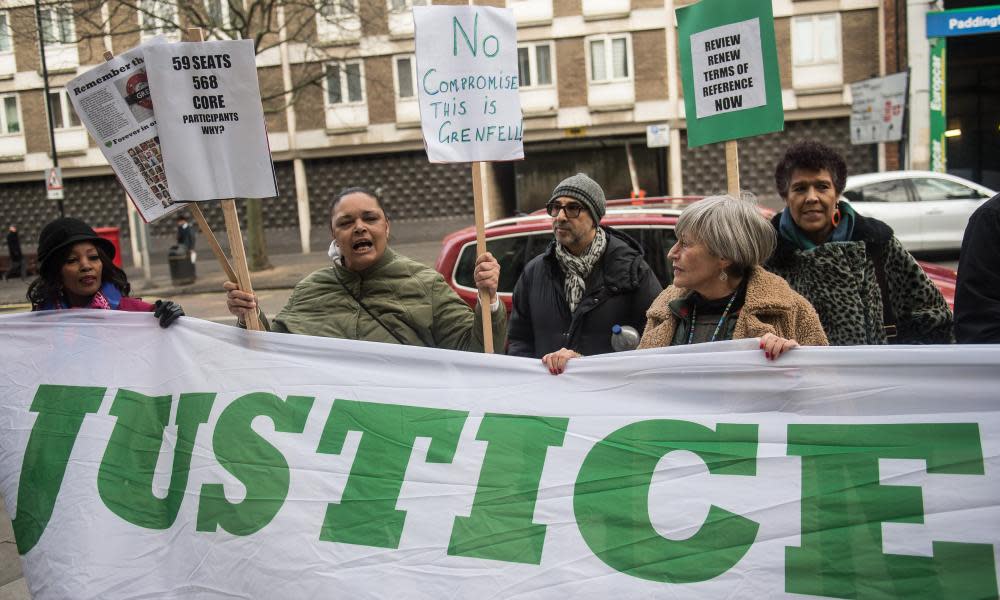Grenfell Tower inquiry resumes but distancing rules anger families

Builders behind the disastrous Grenfell Tower refurbishment are finally set to face public questioning over the June 2017 fire that killed 72 people, as the delayed public inquiry resumes on Monday with strict social distancing rules that have angered the bereaved.
Hundreds of survivors, families and residents are among those who will be prohibited from attending the hearings, which will be conducted with only the inquiry panel, led by Sir Martin Moore-Bick, witnesses, their lawyers and cross-examining inquiry counsel present in the Paddington hearing room. Everyone else is being invited to follow proceedings online.
“For us, a part of the justice process is being able to be in the room when people who are responsible for what happened to our loved ones face questions,” said Karim Mussilhy, the vice-chair of the families group Grenfell United, whose uncle Hesham Rahman died in the fire.
“It’s hard to understand why people are allowed back into pubs, but we’re not allowed back into the inquiry. They told us we would be at the heart of this inquiry and now they are saying we’re not allowed in.”
Some survivors, including Nabil Choucair, who lost six members of his family in the fire, wanted the inquiry to resume only when it could reassemble more fully. But the inquiry said a consultation showed most of the more than 600 participants who responded wanted the inquiry to restart sooner with limited attendance. A plan to run the inquiry entirely by Zoom was ditched amid concerns witnesses could be coached by lawyers off screen.
The inquiry said it “acknowledges the importance of allowing the bereaved, survivors and residents to be present in the building as soon as that is possible”. But given the inquiry was about building safety, it stressed “the particular importance of taking health and safety guidance extremely seriously”.
First under cross-examination under the new conditions will be executives from Exova, the fire engineers accused of playing down non-compliance of the cladding system. They will be followed next week by staff at Rydon, the main contractor that oversaw the selection of the plastic-filled panels that spread the fire.
It will be the first time that Rydon executives – including the project manager, Simon Lawrence – have been questioned in public about their role in the £10m works that broke building regulations and contributed to the greatest loss of life in London since the second world war.
“This next phase of the inquiry process is vital,” said Mussilhy. “We’ll hear from the council, our landlord and all the companies that had a hand in turning Grenfell into a death trap. And we’ll start to unpick the corruption, negligence and indifference that led to the death of 72 of our loved ones. Ultimately we’ll start to see where the blame lies.”
The pause in March triggered by the coronavirus pandemic added to delays caused by legal wrangling over the status of evidence from construction industry executives. They sought and received an undertaking from the attorney general that their testimony would not be used to bring criminal charges against them that could include gross negligence manslaughter.
Survivors are also frustrated that the inquiry will break again for the whole of August and is still only sitting for four days a week. It means the inquiry is unlikely to report back until the end of next year at the earliest, meaning no criminal charges would come until 2022.
The testimony of the main contractors is keenly awaited by the Grenfell residents, many of whom were angered by what they saw as disdainful treatment by contractors during the works between 2014 and 2016.
Before the hiatus, the inquiry heard claims that Lawrence, a key executive, failed to respond during planning to concerns that the cladding might be dangerous and could lead to a repeat of a fire at the Lakanal House tower block in south London in 2009 that killed six people.
Project emails showed Rydon, Exova and the architects Studio E discussing the fire safety of the cladding before its installation, including warnings it might fail. Tony Pearson, of Exova, who will be cross-examined next week, told the architects: “If significant flames are ejected from the windows, this would lead to failure of the cladding system, with the external surface falling away and exposing the cavity.”
In November 2014, an official at the Kensington and Chelsea Tenants Management Organisation asked Lawrence to clarify the “fire retardance of the new cladding”, adding: “I just had a ‘Lacknall [sic] moment,” referring to the earlier fatal fire. Lawrence did not reply, the inquiry has heard.
“This was perhaps the last chance to avert disaster,” lawyers for the bereaved and survivors said. “And it was not taken.”
This week there will also be final evidence from Bruce Sounes, the lead architect from Studio E, who admitted he did not read building regulations aimed at preventing cladding fires and had no idea that panels used to insulate buildings could be combustible. The inquiry also heard that Studio E manipulated its fees to avoid the contract being put out to open tender.

 Yahoo News
Yahoo News 